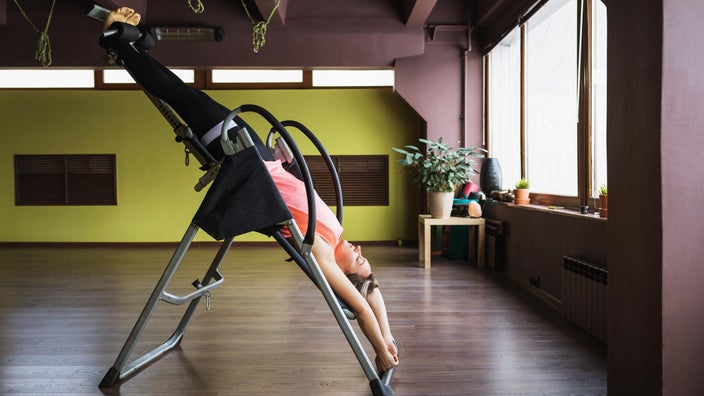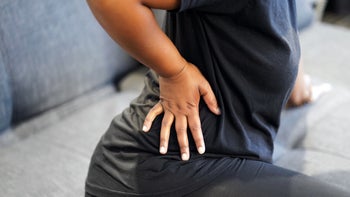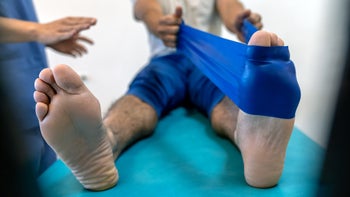
Can an Inversion Table Relieve Your Chronic Back Pain?
Key takeaways:
Inversion therapy is a treatment in which you are suspended upside down to relieve pressure on the spine.
It may ease lower back pain, improve flexibility, and reduce the need for surgery.
Talk to your healthcare provider before you try inversion therapy. This is especially important if you have health conditions such as high blood pressure or heart disease.
Table of contents

If you have chronic lower back pain, you're not alone. An estimated 16 million adults in the U.S. live with this condition. One alternative treatment approach is inversion therapy, in which you are suspended upside down for a brief period. It's designed to take the pressure off of the discs and nerves in the back and may help relieve back pain.
What is inversion therapy?
Inversion therapy started 2,400 years ago in ancient Greece. Hippocrates, often credited as the father of medicine, used the technique. He would use ropes to hoist patients up on a ladder and hang them upside down to relieve back pain. Today, there are specially designed tables, chairs, and anti-gravity boots that healthcare providers may use to offer inversion therapy.
When you stand for long periods, it can cause or exacerbate back pain. Standing reduces the space between your vertebrae and compresses the nerves in your spine. Inversion therapy uses gravity to stretch the spine, creating space between the vertebrae and taking pressure off the nerves and discs that may be causing pain.
Search and compare options
You might not have to hang all the way upside down to reap the benefits of inversion therapy. Research suggests that just 3 minutes spent at a 60-degree tilt may relieve pressure and pain.
Are there different types of inversion therapy?
There are various methods of inversion therapy. A healthcare provider can help you determine which technique is right for you. Common forms of inversion therapy include:
Inversion tables or chairs
Using an inversion table is the most well-known and most thoroughly tested method for inversion therapy. The table is essentially a padded platform that the patient is strapped onto. You use handles, footrests, and your body weight to adjust the table and tilt it to various degrees. For inversion therapy, you’ll usually be somewhere between a 45-degree tilt and a full 90-degree upside-down inversion.
Inversion chairs allow you to start from a seated position before leaning back into an inversion. An inversion chair is a good option for people with limited mobility, older adults, and those with foot or ankle problems.
Gravity boots
Gravity boots are heavy-duty ankle straps that you can attach to a bar in order to hang upside down by your feet. Compared with inversion tables and chairs, gravity boots make it harder to get into an inverted position. They also don't allow you to tilt at different angles. The only option is to hang completely upside down.
Gravity boots were popular in the 1980s, but there aren't recent studies on their effectiveness. One older study found that using gravity boots for more than 2 to 3 minutes can raise your blood pressure to dangerous levels. And they may not be right for people with mobility issues.
Inverted yoga positions
Yoga has many potential benefits, including relief for chronic back pain. For those who want a more active approach, inverted yoga positions may offer benefits similar to those of inversion tables and chairs, though there are currently no studies showing this. Inverted yoga positions include the plow pose, headstands, and handstands. You can use a yoga headstand bench for stability and support to help you hold the pose longer. Make sure you work with a yoga instructor until you can safely master the poses.
Does inversion therapy work for back pain?
Inversion therapy may help with back pain, but there's a need for more research. In a small study, researchers tested inversion therapy in women with chronic lower back pain. After eight weeks of treatment, the women had less pain and better torso flexibility and strength.
A 2021 study examined how inversion therapy affects people with lumbar disc disease and sciatica. Participants used an inversion table daily, in six repetitions spread over 30 minutes, with each lasting at least 2 minutes. After six weeks, 75% of participants reported having less pain and better functionality. But it's worth noting that Teeter Inversion Tables sponsored the study.
Other research suggests that inversion may provide short-term benefits for people with herniated discs in their lower back — but no long-term results. So there's a need for more large-scale studies on this topic.
What are the other benefits of inversion therapy?
Inversion therapy is a form of spinal traction — a therapeutic approach that uses weights and gravity to stretch the spine — so you might hear it referred to that way, as well.
A healthcare provider may recommend inversion therapy for several spine-related conditions, including:
Herniated or bulging discs (also known as lumbar disc disease)
Muscle spasms
Research suggests that inversion therapy may offer additional benefits. These include:
Reduced need for pain medication and back surgery
The same 2021 study found that only 21% of those who had inversion therapy needed surgery after two years, compared with 43% of those who did not receive this treatment. Participants also said they needed less pain medication after treatment.
Another small-scale study examined the effects of inversion therapy in people with lumbar disc disease and sciatica. And 77% of them were able to avoid surgery after treatment. Although the results are promising, larger studies are needed to confirm these benefits.
Increased flexibility and spinal health
Inversion therapy may decrease stiffness, reduce muscle spasms, and increase range of motion in the spine. It can also improve spinal disc circulation, lubrication, and rehydration. This helps keep your spine healthy and functioning.
Who should not use inversion therapy?
It's always a good idea to talk to a healthcare provider before starting a new treatment. Although inversion therapy is non-invasive, it is not safe for everyone. The practice may increase blood pressure and pressure in the head. People affected by the following conditions should avoid inversion therapy or talk to a healthcare professional first:
Heart conditions, including heart disease
History of a stroke
Hernia
Broken bones
Eye conditions such as glaucoma, retinal detachment, or pink eye
Ear infection
Vertigo
Severe acid reflux
Pregnancy
Treatment with certain medications, including blood clotting medications or blood pressure medication
Tips for using an inversion table, chair, or other machine
If your healthcare provider gives you the OK, you can try inversion therapy at home. Remember these safety tips before you get started:
Try it with a professional first
Work with a physical therapist or another medical professional before you try inversion therapy by yourself at home. A professional can monitor you and instruct you on the proper technique.
Make sure you are strapped in correctly
Carefully read the instructions that come with your inversion therapy device. And use all the safety straps provided. This can help you avoid serious injuries, including from falling off the table.
Practice with a spotter
Make sure an adult is nearby as you get used to using the inversion tool.
Ease into inversion
You don’t have to be fully upside down to get the benefits of inversion. So ease into it, starting with a tilt of between 20 and 45 degrees. (The inversion tool you use should show you the angle at which you are inverted.) You can then work your way up to 60 degrees and then to a full 90-degree inversion. This may take several weeks, and there’s no need to get to a full inversion at all, if you aren’t comfortable.
Limit inversion time
Start with short inversion times. Experts recommend trying inversions of less than 60 seconds, with at least a 90-second recovery time between sets. Then, you can work up to 2- or 3-minute inversions, with rests in between. You can scatter inversions throughout the day or do a daily 30-minute session.
Stop if you feel dizziness or pain
Always listen to your body and use comfortable inversion angles. Stop if you experience pain, dizziness, or other uncomfortable symptoms.
Try to relax
To get the full benefits of inversion, you should take deep breaths and relax your body. As you adjust to the feeling of being inverted, you can gently oscillate (rock up and down) while tilted. You can also stretch by holding onto the device’s handles. This can help relax your muscles and lubricate your spine.
Slowly return to the upright position
Make sure you return to the upright position slowly, no matter what angle you use with inversion therapy. And try to avoid sudden movements on the way up.
The bottom line
Inversion therapy may ease lower back pain, especially in people who have a herniated disc. The treatment involves hanging upside down for short periods of time. It may reduce muscle stiffness and help prevent or delay the need for back surgery. Inversion tables are the most popular type of equipment for this therapy, but you can also use an inversion chair or even certain yoga poses. Inversion therapy may not be safe for everyone, so it's best to talk to your healthcare provider before trying it.
Why trust our experts?



References
Ballantyne, B. T., et al. (1986). The effects of inversion traction on spinal column configuration, heart rate, blood pressure, and perceived discomfort. The Journal of Orthopaedic and Sports Physical Therapy.
Cheng, Y. H., et al. (2020). The effect of mechanical traction on low back pain in patients with herniated intervertebral disks: A systemic review and meta-analysis. Clinical Rehabilitation.
Gregory, D. E., et al. (2008). Prolonged standing as a precursor for the development of low back discomfort: An investigation of possible mechanisms. Gait & Posture.
Health Policy Institute. (n.d.). Chronic back pain. Georgetown University.
Heng, M. K., et al. (1992). Changes in cardiovascular function during inversion. International Journal of Sports Medicine.
Jung, S. H., et al. (2021). Inversion table fall injury, the phantom menace: Three case reports on cervical spinal cord injury. Healthcare.
Kim, J.-D., et al. (2013). The effect of inversion traction on pain sensation, lumbar flexibility and trunk muscles strength in patients with chronic low back pain. Isokinetics and Exercise Science.
McMonnies, C. W. (2016). Intraocular pressure and glaucoma: Is physical exercise beneficial or a risk? Journal of Optometry.
Mendelow, A. D., et al. (2021). Lumbar disc disease: The effect of inversion on clinical symptoms and a comparison of the rate of surgery after inversion therapy with the rate of surgery in neurosurgery controls. The Journal of Physical Therapy Science.
Neumann, M. A. (2022). What is spinal traction and does it work for back & neck pain? The Spine Center.
Outside. (n.d.). Inversion yoga poses.
Prasad, K. S. M., et al. (2012). Inversion therapy in patients with pure single level lumbar discogenic disease: A pilot randomized trial. Disability and Rehabilitation.
Teeter. (2020). How to use an inversion table.
Vanti, C., et al. (2020). Effectiveness of mechanical traction for lumbar radiculopathy: A systematic review and meta-analysis. Physical Therapy & Rehabilitation Journal.
Vasiliadis, E. S., et al. (2009). Historical overview of spinal deformities in ancient Greece. Scoliosis.
Zhu, F., et al. (2020). Yoga compared to non-exercise or physical therapy exercise on pain, disability, and quality of life for patients with chronic low back pain: A systematic review and meta-analysis of randomized controlled trials. PLOS One.

























